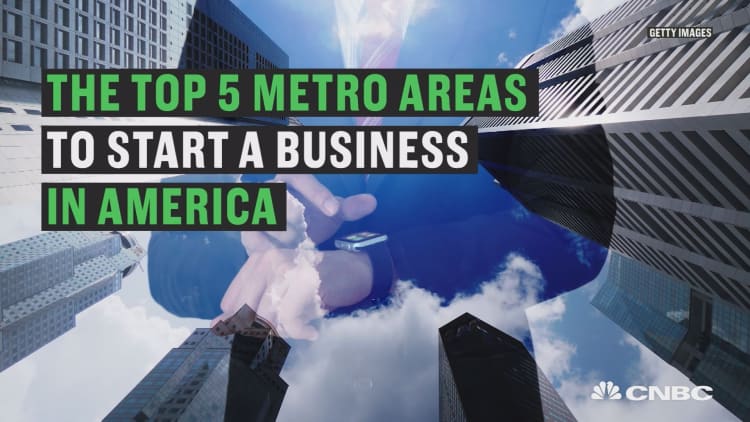If you want to find the U.S. cities with the lowest rates of unemployment, you'll have to leave the coasts and head to what are sometimes called the flyover states.
Among 107 metropolitan areas surveyed by CNBC for its Metro 20 ranking of America's Best Places to Start a Small Business, Provo, Utah, and Omaha, Nebraska, were tied for having the lowest annualized average unemployment rates in the United States in 2015. According to the most recent data from the Bureau of Labor Statistics, as of June 2016 the unemployment rate in Provo stands at 3.9 percent and in Omaha at 3.5 percent.
Both cities, which rank No. 2 and No. 27, respectively, on CNBC's Metro 20 list, have proved to be strong job creators. Reasonable tax rates, burgeoning tech sectors — Provo is part of Utah's "Silicon Slopes," while Omaha is situated in the Midwest's "Silicon Prairie" — and lower costs of living coupled with lower business costs have attracted small businesses to both cities.
In Omaha, the birthplace of Berkshire Hathaway chairman and CEO Warren Buffett and home to four Fortune 500 companies including Berkshire, "the core costs of doing business are lower," said David Brown, president and CEO of the Greater Omaha Chamber of Commerce. "Labor is cheaper here. Land and rent costs are cheaper," he said.
According to a new report from the research arm of real estate firm CBRE, Omaha office rents, at $18.34 per square foot, rank seventh lowest in a comparison of 50 major metropolitan areas in the United States. In that same report, the average Omaha salary was less than that in 35 other metropolitan areas: The average salary for a tech worker, such as a software developer, was $78,579, while the average salary was just above $61,000. Those wages might not be good enough for a San Francisco apartment, but in Omaha, where the average rent is $857 per month, those salaries stretch far.
In Provo, where high-speed Google Fiber internet is available, a similar situation predominates.
Provo wasn't analyzed in the CBRE report from June, but data from the Bureau of Labor Statistics paints some of the picture. Provo office rents are, on average, $18.64 per square foot, according to Salt Lake City-based CBC Advisors. Average hourly wages for software developers or salespeople are lower than the U.S. average.
Provo's economy is helped in part by rapidly growing tech start-ups such as Vivint Smart Home and InsideSales.com, which has grown to more than 600 employees since its founding in 2004 and was recently named to the 2016 CNBC Disruptor 50 list. Thanks to an influx of $60 million in funding in 2015, InsideSales.com, which develops lead-tracking software for salespeople, is one of a handful of Provo-based tech companies valued at more than $1 billion.
More venture capital funding has been coming into the region in recent years. According to the National Venture Capital Association, 21 companies in the Provo metropolitan region were the beneficiaries of 28 total funding deals totaling more than $444 million in 2015. But even more important than the money, argues InsideSales.com founder and CEO Dave Elkington, is the support the company has received from the city of Provo itself.
"The city has been really, really supportive and engaging to help with recruiting [workers]," Elkington said.
"The cost of living is reasonable. There isn't a demand for raising taxes that are passed onto businesses and consumers," said Rona Rahlf, president and CEO of the Utah Valley Chamber of Commerce, based in Provo. "When I do ribbon-cuttings, you ask businesses about their experiences with the city: little to no delays with permits and very accommodating."
Social factors and cultural amenities, be they outdoor activities like hiking or skiing or indoor trips to museums and theaters, can also have an indirect impact on a city's business climate. In Provo and Omaha, the feeling CEOs and local leaders get is that people who move there for work are also looking for the type of place where they can plant roots and raise families.
"We have spent lots of time and money to make sure we have most of the amenities that people want for a good quality of life," Brown of the Greater Omaha Chamber of Commerce said. "We find that people arrive thinking they'll spend a short time here and they end up staying here for decades."
Omaha's local business owners have an easy time ticking off the cultural attractions: the Joslyn Art Museum, the main fine-arts museum in the state; the Holland Performing Arts Center, where musicians like Elvis Costello perform; and Big Omaha, an annual springtime entrepreneurship conference.
Both cities benefit from large pools of younger workers that graduate from local universities each year. Elkington estimates that companies in Provo have around 12,000 college graduates to pick from each year, including those who are already in town because they attend Brigham Young University. A little more than 14,000 students attend the University of Nebraska Omaha.
While both Provo and Omaha receive help at the state level in attracting employers, Omaha has also found ways to overcome state-level weaknesses in Nebraska.
The Tax Foundation ranks Nebraska in the bottom half of U.S. states in its Business Tax Climate Index, a listing that compares states based on taxes that have the most impact on businesses, such as individual income and sales taxes. But a recent KPMG report that ranked cities based on their business competitiveness noted that, among 27 midsize Midwest cities, Omaha ranked fourth overall after assessing a variety of categories that might affect a small business, including electricity costs, effective corporate income-tax rates and overall labor costs.
Tax incentives and microloans also support small businesses and drive job growth. At the local level in Omaha, that task falls to the Omaha Small Business Network, which has doled out $1.8 million in microloans to small businesses over the last decade. Most of the loans are $50,000, with interest rates around 8 percent, and have gone to small accounting firms, restaurants and similar businesses.
The money comes from banks and private donors, according to executive director Julia Parker, and is reserved for businesses that haven't been able to secure a loan from a traditional financial institution, something not necessarily the fault of a business itself.
"There can be a variety of reasons why you can't access capital," said Parker. "But the ability to obtain a small-business loan is really the indicator of whether a business will be successful."
For James Overton, an Omaha transplant and founder of real estate development company Lantex, a $50,000 loan from the Omaha Small Business Network ensured he could keep payroll going for his 11 full-time employees while taking on new real estate projects.
"You have a lot of things that'll help catapult your business off the ground," he said. "In major cities, before you even open your doors, your overhead is so high that you can't actually flourish in the first few years. In Omaha you should start being able to turn a profit in the first 24 months."
In Omaha you should start being able to turn a profit in the first 24 months.James Overtonan Omaha transplant and founder of real estate development company Lantex

In addition, a host of innovation programs with state backing have given small companies in Omaha a boost, according to Courtney Dentlinger, director of the Nebraska Department of Economic Development. Just one example is the $500,000 investment made by Invest Nebraska — set up in the early 2000s with financial help from the state's Department of Economic Development — in Omaha-based D3 Banking. The money helped the company commercialize its digital-banking software and, in the process, hire an additional 39 employees. By the end of this year, D3 Banking expects to grow from 65 full-time employees to more than 100.
"The job growth [in Omaha] comes from small businesses," Brown said. "We have thousands of small businesses that are aggressive and growing very quickly."
Companies in Provo have received similar help from the state of Utah, which is ranked ninth in the Tax Foundation's Business Tax Climate Index. One tax credit in particular — the EDTIF credit — has been used by multiple companies, including research software company Qualtrics, another Provo-based unicorn tech company. A performance-based refundable tax credit, the EDTIF is eligible for companies who commit to creating jobs where those jobs would pay in excess of the local average salary. In turn, those companies receive a rebate on local taxes.
According to Theresa Foxley, deputy director of the Utah Governor's Office of Economic Development, there are fundamentals that make for a strong foundation of any business-friendly city, among them "a favorable tax climate, a great education system [and] a regulatory environment that doesn't impede business growth but still maintains health and safety."
In Provo and Omaha, those fundamentals are at work. "Capital's a coward," Foxley said. "It goes where it's welcome."
— By Andrew Zaleski, special to CNBC.com





